H. Huang, P.-Y. Chien, C.
H. Huang, P.-Y. Chien, C.
H. Huang, P.-Y. Chien, C.
Create successful ePaper yourself
Turn your PDF publications into a flip-book with our unique Google optimized e-Paper software.
March 2003 Notes Chem. Pharm. Bull. 51(3) 339—340 (2003) 339<br />
Novel Synthesis of Flavonoids of Scutellaria baicalensis GEORGI<br />
Wen-Hsin HUANG, Pei-Yu CHIEN, Ching-Huey YANG, and An-Rong LEE*<br />
School of Pharmacy, National Defense Medical Center; Taipei, Taiwan.<br />
Received October 15, 2002; accepted December 12, 2002<br />
A concise and efficient total synthesis of the flavonoids baicalein, oroxylin A and wogonin was described. Intramolecular<br />
oxidative cyclization followed by demethylation of chalcone 1, readily prepared from trimethoxyphenol,<br />
afforded, depending upon the controlled conditions, baicalein or oroxylin A in excellent yields. Demethylation<br />
of 1 yielded 3, which, by oxidation with I 2 /dimethyl sulfoxide (DMSO), was readily converted to oroxylin A<br />
and wogonin after column chromatography.<br />
Key words baicalein; oroxylin A; wogonin<br />
Baicalein, oroxylin A and wogonin are the three major<br />
flavonoids of Scutellaria baicalensis GEORGI, a traditional<br />
Chinese herb used since the ancient time, characterized by<br />
possessing a very broad spectrum of biological activities, notably<br />
anti-oxidant. 1) In literature, there have been no appropriate<br />
approaches available for a facile synthesis of those<br />
structurally similar flavonoids. Our interests in their unique<br />
pharmacological properties prompted us to pursue a pertinent<br />
route toward the very efficient preparation of such<br />
highly prized targets.<br />
In general, procedures for laboratory synthesis of<br />
flavonoids are still based today on the approaches originally<br />
developed by Robinson 2) or exerted by the Baker–Venkataraman<br />
rearrangement, 3,4) synthesis via chalcones, 5) and synthesis<br />
via an intramolecular Wittig reaction. 6) At the outset, we<br />
followed the reported methods specifically for the synthesis<br />
of baicalein, 7,8) oroxylin A 9) and wogonin. 10) However, we<br />
found that they all suffered either from involving a number of<br />
steps giving too low overall yields or from encountering con-<br />
Chart 1<br />
siderable challenges due to irreproducible workout. Attempts<br />
to synthesize baicalein from trimethoxyphenol by either the<br />
modified conventional Baker–Venkataraman approach 11)<br />
proved to be impractical (below 10% yield) or the Wittig<br />
strategy 6) completely failed. Therefore, our strategy for synthesis<br />
of baicalein turned to employing chalcone 1 as the<br />
starting material while the demethylation was performed at<br />
the last stage.<br />
Our approaches (Chart 1) for construction of baicalein,<br />
oroxylin A and wogonin relied on the preparation of flavone<br />
* To whom correspondence should be addressed. e-mail: lar@ndmctsgh.edu.tw © 2003 Pharmaceutical Society of Japan
340 Vol. 51, No. 3<br />
2 and chalcone 3 as penultimate targets derived from chalcone<br />
1, readily prepared by treatment of easily accessible<br />
trimethoxyphenol with excessive acetic acid in the presence<br />
of BF 3 –Et 2 O, 12) followed by a Claisen-Schmidt condensation<br />
with equimolar benzaldehyde, 3,4) best catalyzed by KOH, in<br />
66% overall yield. Alternatively, a better yield (90%) was<br />
achieved by direct acylation of trimethoxyphenol with<br />
equimolar cinnamoyl chloride, also in the presence of<br />
BF 3 –Et 2 O.<br />
One of the most common methods in preparation for<br />
flavonoids such as 2 involves an intramolecular oxidative cyclization<br />
of chalcone, 5) i.e. 1. However, formation of the prerequisite<br />
flavone 2 triggered by SeO 2 /EtOH 7,13) or Pd(OAc) 2 /<br />
AcCN 14) consistently led to extremely low yields (below<br />
10%). This difficulty of cyclization, the phenyl ring bearing<br />
polyphenols (more than 3 OH’s) later turned out to be the<br />
culprit, made us turn to non-metal oxidants. Among them,<br />
I 2 /dimethyl sulfoxide (DMSO) 15) proved to be the most<br />
promising and the reaction proceeded smoothly and ended up<br />
with 2 in a much superior yield (87%). Surprisingly, attempted<br />
demethylation of 2 to obtain baicalein in a solution<br />
of 47% HBr/AcOH (1 : 2) at reflux for 2 h gave, after isolation,<br />
an unexpected yet desired product oroxylin A (88%) exclusively,<br />
validated by fruitless acetonidation in addition to<br />
spectroscopy. 16) Further reaction under the same condition<br />
over 12 h yielded baicalein (81%). Alternatively, a straight<br />
18-h hydrolysis of 2 proceeded in the same methodology also<br />
afforded baicalein in excellent yield (89%).<br />
In a similar fashion, demethylation of 1 in a solution of<br />
47% HBr/HOAc (1 : 2) at reflux for 2 h gave 3 (91%) which<br />
was susceptible to oxidation with I 2 /DMSO to procure a mixture<br />
of oroxylin A (46%) and wogonin (24%), readily separated<br />
by flash chromatography.<br />
In conclusion, we have successfully attained an extremely<br />
efficient route for the preparation of baicalein, oroxylin A,<br />
and wogonin. To our best knowledge, for total synthesis of<br />
these three pharmacologically diversified flavonoids, our approach<br />
is the only practical path featuring in beginning with<br />
a common starting material, using affordable reagents and<br />
proceeding under mild conditions and thus suitable for largescale<br />
pilot-plant synthesis. Various flavone derivatives are<br />
now being prepared in our laboratory by the above-mentioned<br />
methodology with a view to extensively evaluating<br />
their biological activities. The experimental details and biological<br />
data will be published shortly.<br />
Experimental<br />
Melting points were determined on a Buchi-530 melting point apparatus<br />
(uncorrected). IR spectra were recorded on a Perkin-Elmer FT-IR 1600 series<br />
FT-IR spectrophotometer. 1 H-NMR spectra were determined on a Varian<br />
Gemini-300 NMR instrument. Mass spectra were recorded on a Finnigan<br />
MAT TSQ-46 or Finnigan MAT TSQ-700 mass spectrometer. UV spectra<br />
were recorded on a Shimadzu UV-160A spectrophotometer.<br />
1-(2,3,4-Trimethoxy-6-hydroxyphenyl)-3-phenylpropen-1-one (1) A<br />
mixture of 3,4,5-trimethoxyphenol (3.7 g, 20 mmol) and cinnamoyl chloride<br />
(3.7 g, 22 mmol) was dissolved in BF 3 –Et 2 O complex (20 ml) and heated to<br />
reflux for 15 min, and then quenched with excess of water. Filtration and recrystallization<br />
from hexane : EtOAc (3 : 1) gave chalcone 1 (5.6 g, 90%) as<br />
reddish-yellow crystals. Alternatively, 1 could be prepared by acylation of<br />
3,4,5-trimethoxyphenol 12) and, without further purification, followed by condensation<br />
with benzaldehyde in the presence of KOH 3,4) (66%): mp 98—<br />
100 °C. 1 H-NMR (CDCl 3 ) d: 3.82 (3H, s), 3.96 (3H, s), 4.03 (3H, s), 6.34<br />
(1H, s), 7.45—7.48 (3H, m), 7.67 (2H, d, J�9.3 Hz), 8.06 (2H, d, J�15.5<br />
Hz), 8.33 (2H, d, J�15.5 Hz). IR (KBr) cm �1 : 3419, 1608. MS m/z: 315<br />
(MH � ).<br />
5,6,7-Trimethoxyflavone (2) A mixture of 1 (7.2 g, 23 mmol) and iodine<br />
(200 mg) in DMSO (25 ml) was refluxed for 2 h, and then carefully<br />
poured onto crushed ice (200 g). The precipitate was filtered and washed<br />
with 20% Na 2 SO 3 . Purification by flash column chromatography (SiO 2 ,<br />
hexane : EtOAc�3 : 1) yielded 6.3 g (87%) of 2 as white crystals, which<br />
turned into pale yellow after standing for about one month, and recovered<br />
0.8 g (2.5%) of 1: mp 146—147 °C (lit. 17) 164—165 °C). 1 H-NMR (DMSOd<br />
6 ) d: 3.93 (3H, s), 3.97 (3H, s), 3.99 (3H, s), 6.72 (1H, s), 6.83 (1H, s), 7.50<br />
(3H, m), 7.88 (2H, d, J�8.7 Hz). IR (KBr) cm �1 : 1633. MS m/z: 313<br />
(MH � ).<br />
Oroxylin A A solution of 2 (0.20 g, 0.64 mmol) in 47% HBr (5 ml) and<br />
glacial acetic acid (10 ml) was refluxed for 2 h, and then carefully poured<br />
onto crushed ice (200 g). The resulting yellow precipitate was filtered and<br />
collected. Recrystallization from ethanol afforded 160 mg (88%) of oroxylin<br />
A as bright yellow crystals: mp 203—204 °C. (lit. 9) 195—197 °C). 1 H-NMR<br />
(DMSO-d 6 ) d: 3.91 (3H, s), 6.94 (1H, s), 6.98 (1H, s), 7.59 (3H, m), 8.10<br />
(2H, d, J�6.3 Hz), 8.77 (1H, s), 12.49 (1H, s). IR (KBr) cm �1 : 3435, 1667.<br />
UV l max (EtOH) nm (log e): 322 (4.12), 278 (4.35), 216 (4.42). MS m/z: 285<br />
(MH � ).<br />
Baicalein Baicalein, as bright yellow crystals, was prepared by the<br />
modified procedure outlined above either from oroxylin A (reflux, 12 h) or 2<br />
(reflux, 18 h) in 81% and 89% yield, respectively: mp 258—260 °C (lit. 7)<br />
263—264 °C). 1 H-NMR (DMSO-d 6 ) d: 6.61 (1H, s), 6.92 (1H, s), 7.56 (3H,<br />
m), 8.05 (2H, d, J�8.1 Hz), 8.81 (1H, s), 10.57 (1H, s), 12.65 (1H, s). IR<br />
(KBr) cm �1 : 3411, 1654. UV l max (EtOH) nm (log e): 326 (4.17), 276<br />
(4.42), 215 (4.49). MS m/z: 270 (M � ).<br />
Wogonin Pure 3 (0.52 g, 1.8 mmol), prepared by the procedure outlined<br />
above (reflux, 2 h) from chalcone 1 (0.62 g, 2.0 mmol) in 91% yield, was<br />
subject to oxidative cyclization as previously described. Purification by flash<br />
chromatography (silica gel, CH 2 Cl 2 ®hexane/EtOAc (3/1)®CH 2 Cl 2 /EtOAc<br />
(5/1)) and then recrystallization from ethanol gave oroxylin A (238 mg,<br />
46%) and bright yellow crystals of wogonin (124 mg, 24%), respectively.<br />
Chalcone 3: mp 121—122 °C. 1 H-NMR (DMSO-d 6 ) d: 2.78 (1H, d, J�13.4<br />
Hz), 3.82 (3H, s), 5.56 (1H, d, J�13.4 Hz), 6.27 (1H, s), 7.40—7.54 (5H,<br />
m), 8.21 (1H, s), 11.72 (1H, s). IR (KBr) cm �1 : 3445, 1666. FAB-MS m/z: 287<br />
(MH � ); Wogonin: mp 198—199 °C. (lit. 10) 203 °C). 1 H-NMR (DMSO-d 6 ) d:<br />
3.81 (3H, s), 6.30 (1H, s), 7.00 (1H, s), 7.37 (1H, s), 7.64 (3H, m), 8.10 (2H,<br />
d, J�6.3 Hz), 12.51 (1H, s). IR (KBr) cm �1 : 3445, 1667. UV l max (EtOH)<br />
nm (log e): 321 (4.15), 276 (4.36), 216 (4.44). FAB-MS m/z: 285 (MH � ).<br />
Acknowledgements We gratefully acknowledge the research grants<br />
NSC 91WFE0100105 and 91WFE0100114 supported in part from the National<br />
Science Council of the Republic of China.<br />
References<br />
1) Gao D., Sakuria K., Chen J., Ogiso T., Res. Commun. Mol. Pathol.<br />
Pharm., 90, 103—114 (1995).<br />
2) Allan J., Robinson R., J. Chem. Soc., 2192—2194 (1924).<br />
3) Mahal H. S., Venkataraman K., Curr. Sci., 4, 214—216 (1933).<br />
4) Wheeler T. S., “Organic Syntheses,” Collective Vol. IV, 2nd ed. by<br />
Rabojohn N., John Wiley & Sons, New York, 1967, pp. 478—481.<br />
5) Iinuma M., Iwashima K., Matsuura S., Chem. Pharm. Bull., 32,<br />
4935—4941 (1984).<br />
6) Hercouet A., LeCorre M., LeFloc’h Y., Synthesis, 1982, 597—598<br />
(1982).<br />
7) Schonberg A., Badran N., Starkowsky N. A., J. Am. Chem. Soc., 77,<br />
5390—5392 (1955).<br />
8) Agasimundin Y. S., Siddappa S., J. Chem. Soc., Perkin Trans. I, 503—<br />
505 (1973).<br />
9) Popova T. P., Chem. Nat. Compd. (Engl. Transl.), 11, 97—99 (1975).<br />
10) Hattori S., Hayashi K., Chem. Ber., 66, 1279—1280 (1933).<br />
11) Ares J. J., Outt P. E., Kakodkar S. V., Buss R. C., Geiger J. C., J. Org.<br />
Chem., 58, 7903—7905 (1993).<br />
12) Chiba K., Takakuwa T., Tada M., Yoshii T., Biosci. Biotechnol.<br />
Biochem., 56, 1769—1772 (1992).<br />
13) Price W. A., Silva A. M. S., Cavaleiro J. A. S., Heterocycles, 36,<br />
2601—2612 (1993).<br />
14) Kasahara A., Izumi T., Oshima M., Bull. Chem. Soc. Jpn., 47, 2526—<br />
2528 (1974).<br />
15) Pinto D. C. G. A., Silva A. M. S., Cavaleiro J. A. S., J. Heterocyclic<br />
Chem., 33, 1887—1893 (1996).<br />
16) Levene P. A., Raymond A. L., J. Biol. Chem., 102, 317—346 (1933).<br />
17) McGarry L. W., Detty M. R., J. Org. Chem., 55, 4349—4356 (1990).


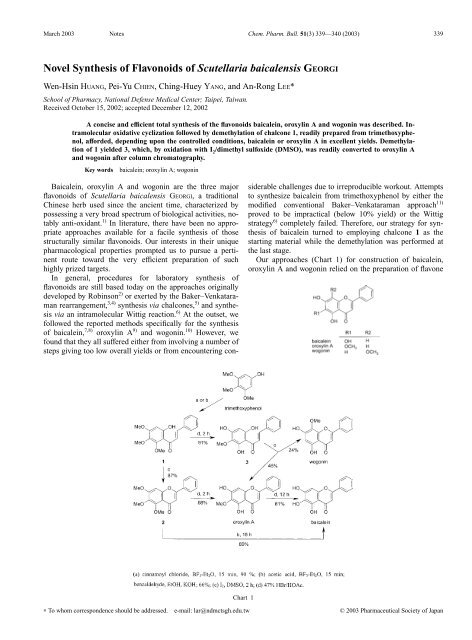
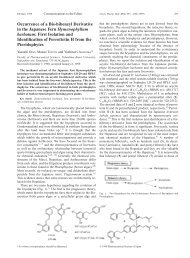

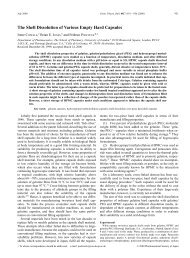
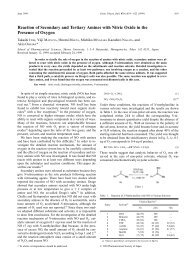
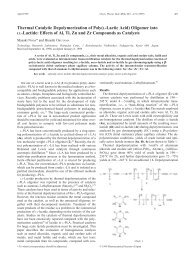
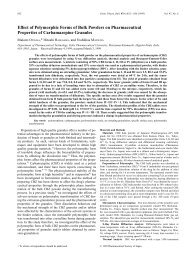
![Synthesis of 1-Azabicyclo[3.3.0]octane Derivatives and Their Effects ...](https://img.yumpu.com/5454096/1/190x259/synthesis-of-1-azabicyclo330octane-derivatives-and-their-effects-.jpg?quality=85)